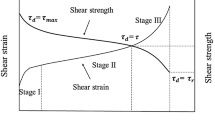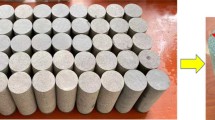Abstract
The long-term compression–shear–seepage coupling of rock mass is a cause of many engineering geological disasters. This study aimed to explore the creep characteristics of rock mass under different seepage conditions. Based on the shear-creep–seepage test results of shale, the shear-creep–seepage model considering damage was constructed using a series connection of the elastomer (H), a nonlinear viscoelastic body with nonlinear function \(\lambda \) (NVEP), a viscoplastic body with seepage switch \(S\) (VPB), and a viscoelastic–plastic body considering damage (VEPB). The variation law of the model parameters was analyzed, and the results showed that the model effectively described the entire change process of rock-creep characteristics, notably the deformation law of the accelerated-creep stage. The correlation coefficient \(R^{2}\) was greater than 0.98, and the fitting curve was highly consistent with the experimental data. Furthermore, the greater the seepage-water pressure, the smaller the shear stress applied in the corresponding test of each stage, and the greater the cumulative shear strain of each stage. Moreover, the seepage-water pressure had a damaging effect on the mechanical strength of the rock samples. The parameter values \(k_{1}\) and \(\lambda \) were negatively correlated with seepage-water pressure and shear stress, whereas the parameter values \(k_{2}\) and \(\eta _{1}\) were negatively correlated with seepage-water pressure and positively correlated with shear stress. The results of this study can provide theoretical support for the research and analysis of rock-mass engineering stability under long-term seepage conditions.










Similar content being viewed by others
Availability of data and materials
The data used to support the findings of this study are available from the corresponding author upon request.
Code Availability
Not applicable.
References
Chen, W.Z., Lu, C., Yu, H.D., et al.: Progress in long-term mechanical properties of clay rocks under thermo-hydro-mechanical coupling conditions. Chin. J. Rock Mech. Eng. 40(02), 233–247 (2021b). https://doi.org/10.13722/j.cnki.jrme.2020.0070
Chen, G.Q., Wan, Y., Sun, X., et al.: Research on creep behaviors and fractional order damage model of sandstone subjected to freeze-thaw cycles in different temperature ranges. Chin. J. Rock Mech. Eng. 40(10), 1962–1975 (2021a). https://doi.org/10.13722/j.cnki.jrme.2021.0064
Hou, J., Guo, Z., Li, J., et al.: Study on triaxial creep test and theoretical model of cemented gangue-fly ash backfill under seepage-stress coupling. Constr. Build. Mater. 273, 121722 (2021). https://doi.org/10.1016/j.conbuildmat.2020.121722
Li, X.Z., Ban, L.R., Qi, C.Z.: Study on the mechanical model of macro-mecro creep under high seepage pressure in brittle rocks. Rock Soil Mech. 41(12), 3987–3995 (2020). https://doi.org/10.16285/j.rsm.2020.0453
Li, Z.Y., Yang, G.S., Wei, Y.: Study on creep mechanical properties of frozen Cretaceous sandstone during thawing process. Chin. J. Rock Mech. Eng. 40(09), 1777–1788 (2021). https://doi.org/10.13722/j.cnki.jrme.2021.0413
Li, X.Z., Jia, Y.X., Yan, H.W., et al.: Mechanism of micro and macro mechanics in brittle rocks during cyclic creep under high seepage pressure. Adv. Eng. Sci., 1–12 [2023-02-13]. https://doi.org/10.15961/j.jsuese.202200431
Liu, X.L., Cao, Z.G., Chen, S.S., et al.: Seepage field analysis and optimal schedule of distributed underground reservoir in mining area. J. China Coal Soc. 44(12), 3693–3699 (2019b). https://doi.org/10.13225/j.cnki.jccs.SH19.1167
Liu, D., Pu, H., Ju, Y., et al.: A new nonlinear viscoelastic-plastic seepage-creep constitutive model considering the influence of confining pressure. Therm. Sci. 23, 116 (2019a). https://doi.org/10.2298/TSCI180621116L
Liu, Y., Chen, D.X., Wang, H., et al.: Response analysis of residual soil slope considering crack development under drying-wetting cycles. Rock Soil Mech. 42(07), 1933–1943+1982 (2021). https://doi.org/10.16285/j.rsm.2020.1504
Long, A.F., Chen, K.S., Ji, Y.X.: Experimental study on wetting-drying cycles of red clay slopes under different rainfall intensities. Chin. J. Geotechn. Eng. 41(2), 193–196 (2019)
Ma, L.Y., Hu, B., Chen, Y., et al.: Study of shear-seepage properties of intact argillaceous shale under different injection water pressures. Rock Soil Mech. 43(09), 2515–2524 (2022a). https://doi.org/10.16285/j.rsm.2021.2013
Ma, L.Y., Hu, B., Liu, J., et al.: Study on shear creep damage characteristics of shale block under impact disturbance. Chin. J. Solid Mech. 43(05), 646–657 (2022b). https://doi.org/10.19636/j.cnki.cjsm42-1250/o3.2022.021
Shi, Z.M., Shen, D.Y., Zhang, Q.Z., et al.: Experimental study on the coupled shear flow behavior of jointed rock samples. Eur. J. Environ. Civ. Eng. 22, s333–s350 (2018). https://doi.org/10.1080/19648189.2017.1390498
Sun, X.M., Miu, C.Y., Jiang, M., et al.: Experimental and theoretical study on creep behaviors of sandstone with different moisture contents based on modified Nishihara model. Chin. J. Rock Mech. Eng. 40(12), 2411–2420 (2021). https://doi.org/10.13722/j.cnki.jrme.2021.0302
Tang, C.S., Shi, B., Liu, C., et al.: Experimental characterization of shrinkage and desiccation cracking in thin clay layer. Appl. Clay Sci. 52(1–2), 69–77 (2011). https://doi.org/10.1016/j.clay.2011.01.032
Wang, Y.G.: The analyse and countermeasures study on the balance of coal market supply and demand in China. Shanxi University of Finance and Economics (2007)
Wang, J.G., Liang, B., Yang, P.J.: Creep experiment and nonlinear disturbance creep model of gneiss under dynamic and static load. J. China Coal Soc. 44(1), 192–198 (2019). https://doi.org/10.13225/j.cnki.Jccs.2018.5036
Wang, J.G., Sun, Q.G., Liang, B., et al.: Permeability evolution law of shale under cyclic loading and unloading of osmotic pressure. J. Vib. Shock 40(07), 253–259 (2021a). https://doi.org/10.13465/j.cnki.jvs.2021.07.034
Wang, X.K., Xia, C.C., Zhu, Z.M., et al.: Long-term creep law and constitutive model of extremely soft coal rock subjected to single-stage load. Rock Soil Mech. 42(08), 2078–2088+2098 (2021). https://doi.org/10.16285/j.rsm.2021.0178
Wang, J.G., Zhang, Q.X., Sun, Q.L., et al.: Macro-meso damage and fracture model for determining the creep characteristics of shale under osmotic pressuresure. J. Mater. Res. Technol. 17, 2084–2097 (2022). https://doi.org/10.1016/J.JMRT.2022.01.146
Xia, C.C., Yu, Q.F., Qian, X., et al.: Experimental study of shear-seepage behaviour of rock joints under constant normal stiffness. Rock Soil Mech. 41(01), 57–66+77 (2020). https://doi.org/10.16285/j.rsm.2018.2275
Xu, T., Zhou, G.L., Heap, M.J., et al.: The modeling of time-dependent deformation and fracturing of brittle rocks under varying confining and pore pressures. Rock Mech. Rock Eng. 51(10), 3241–3263 (2018). https://doi.org/10.1007/s00603-018-1491-4
Yang, C., Xu, X., Wang, L.H., et al.: Relationship between creep characteristics of intact rock and single-flawed sandstone under different critical stress intervals. Chin. J. Rock Mech. Eng. 41(07), 1347–1357 (2022). https://doi.org/10.13722/j.cnki.jrme.2021.0809
Zhang, L.L., Wang, X.J.: Study on composite creep model of rock considering viscoelastic plastic strain separation. J. Cent. South Univ., Sci. Technol. 52(5), 1655–1665 (2021). https://doi.org/10.11817/j.issn.1672-7207.2021.05.026
Zhang, Z., Fu, X., Sheng, Q., et al.: Effect of rainfall pattern and crack on the stability of a red bed slope: a case study in Yunnan Province. Adv. Civ. Eng. 2021(1), Article ID 6658211 (2021)
Zhang, S.L., Liang, W.G., Xiao, N., et al.: A fractional viscoelastic-plastic creep damage model for salt rock considering temperature effect. Chin. J. Rock Mech. Eng. 41(S2), 3198–3209 (2022). https://doi.org/10.13722/j.cnki.jrme.2021.1237
Zhao, Y., Wang, Y., Wang, W., et al.: Modeling of rheological fracture behavior of rock cracks subjected to hydraulic pressure and far field stresses. Theor. Appl. Fract. Mech. (2019). https://doi.org/10.1016/j.tafmec.2019.01.026
Zhao, L.Y., Lai, Y.M., Niu, F.J., et al.: Multi-scale damage creep model and long-term strength for hard brittle rocks. J. Cent. South Univ., Sci. Technol. 53(8), 3071–3080 (2022). https://doi.org/10.11817/j.issn.1672-7207.2022.08.024
Zhou, C., Yu, L., You, F., et al.: Coupled seepage and stress model and experiment verification for creep behavior of soft rock. Int. J. Geomech. 20(9), 04020146 (2020). https://doi.org/10.1061/(ASCE)GM.1943-5622.0001774
Zhou, R.H., Chen, Y., Cai, H.B., et al.: Creep characteristics and creep model of siltstone under triaxial compression and graded unloading. Chin. J. Rock Mech. Eng. 41(06), 1136–1147 (2022). https://doi.org/10.13722/j.cnki.jrme.2021.1116
Funding
This study was supported by The National Natural Science Foundation of China (52204135), the Liaoning BaiQianWan Talents Program, the Basic Research Projects of Colleges and Universities in Liaoning Province (LJKQZ2021155), the Discipline Innovation Team of Liaoning Technical University (LNTU20TD-01), and the 2021 College Student Innovation and Entrepreneurship Training Program (202110147011).
Author information
Authors and Affiliations
Contributions
All authors contributed to the study’s conception and design. Material preparation, data collection, and analysis were performed by Guanghe Li, Yanting Wang, Dong Wang, Laigui Wang, Shipeng Zhang, Cunjin Li, Ruixue Teng. The first draft of the manuscript was written by Guanghe Li and Yanting Wang. All authors read and approved the final manuscript.
Corresponding author
Ethics declarations
Competing interests
The authors declare no competing interests.
Additional information
Publisher’s Note
Springer Nature remains neutral with regard to jurisdictional claims in published maps and institutional affiliations.
Rights and permissions
Springer Nature or its licensor (e.g. a society or other partner) holds exclusive rights to this article under a publishing agreement with the author(s) or other rightsholder(s); author self-archiving of the accepted manuscript version of this article is solely governed by the terms of such publishing agreement and applicable law.
About this article
Cite this article
Li, G., Wang, Y., Wang, D. et al. The creep behavior of rock shear seepage under different seepage-water pressures. Mech Time-Depend Mater 27, 351–365 (2023). https://doi.org/10.1007/s11043-023-09601-3
Received:
Accepted:
Published:
Issue Date:
DOI: https://doi.org/10.1007/s11043-023-09601-3




